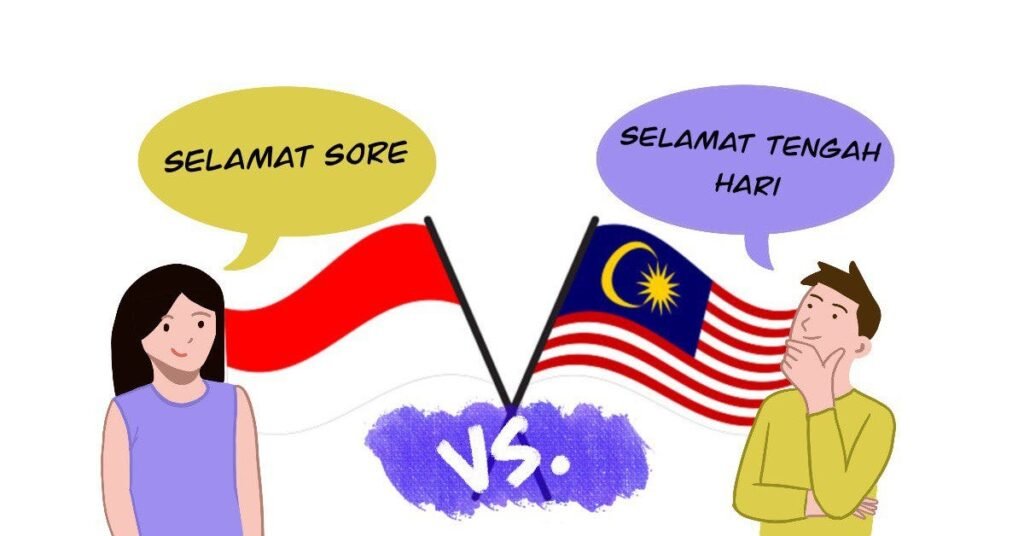Indonesian and Malaysian are two closely related languages yet differ mainly in accent, pronunciation, and vocabulary. While Indonesian is the official language of Indonesia, Malaysian, or Bahasa Malaysia, serves as Malaysia’s national language.
Exploring the intricacies of Indonesian and Malaysian languages reveals a fascinating tapestry of linguistic similarities intertwined with distinct national identities. These languages emerged from the Malay language, which explains their common roots and mutual intelligibility to a large extent. However, the divergence in historical influences and cultural integrations has led to noticeable differences.
A traveler or linguist will detect variations in spelling and colloquialisms unique to each country. Language learners should also note that formal education and media in both countries utilize their respective standardized forms. Understanding the nuances of Indonesian and Malaysian is imperative for successful communication and cultural appreciation in Southeast Asia.

Credit: www.quora.com
Introduction To The Languages
Indonesian and Malaysian are two fascinating languages. At first glance, they appear very similar. But, they have their own unique stories. These languages stem from the same family but have evolved distinctly. This section cracks open the linguistic shells of these neighboring languages to explore their origins.
Origins Of Indonesian Language
The Indonesian language, known as Bahasa Indonesia, has a rich history. It is the official language of Indonesia. Derived from the Malay language, it became the language of unity for diverse ethnic groups. Its formation involved adopting words from local dialects, Dutch, and other foreign languages.
Origins Of Malaysian Language
On the other side, the Malaysian language, or Bahasa Malaysia, serves as Malaysia’s official tongue. Sharing roots with Indonesian, it has absorbed different influences. British colonialism and the native languages of the Malaysian Peninsula shaped its development.

Credit: www.quora.com
Similarities Between Indonesian And Malaysian
The Indonesian and Malaysian languages are like close siblings in the linguistic world. They share much in common, delighting speakers who discover the ease with which they can understand each other. Let’s explore these kindred tongues, tracing their similarities in roots and their mutual understanding.
Shared Linguistic Roots
Indonesian and Malaysian both stem from the Malay language. This link goes back centuries. As neighbors, Indonesia and Malaysia drew from the same linguistic well. They formalized their languages based on classical Malay. Their alphabets closely resemble one another, easing the learning curve.
Mutual Intelligibility
Travelers from Indonesia can easily chat with locals in Malaysia. Why? Because these languages are mutually intelligible. Speakers can understand most of each other’s words and phrases. Though some vocabulary and pronunciation differ, basic communication typically flows smoothly across this linguistic bridge.
Curious about how much Indonesians and Malaysians grasp each other’s language? Consider this: if two people, one from each country, meet, they can converse with minor adjustments. They recognize shared words and structures. This closeness helps foster a natural bond between these Southeast Asian neighbors.
Key Differences In Pronunciation
When exploring Indonesian and Malaysian languages, pronunciation stands out as a primary distinction. While the two languages have similar roots, their sounds can vastly differ. Understanding these differences is crucial for learners and speakers to communicate effectively. Let’s delve into the key pronunciation differences.
Vowel Sounds Variations
Vowel sounds in Indonesian and Malaysian often have subtle, yet vital distinctions.
- Indonesian typically features a clear ‘a’ sound, like ‘father’.
- Malaysian vowels might be shorter or merged, altering the sound.
These variations can change word meanings. So, speakers must pay attention to how vowels form in each language.
Consonant Usage
The usage of consonants presents notable differences between the two languages.
| Feature | Indonesian | Malaysian |
|---|---|---|
| Final ‘k’ | Silent | Pronounced |
| ‘c’ Sound | Like ‘ch’ in ‘check’ | Varies, can be like ‘s’ |
These consonant rules affect clarity in speech. Learners should practice these nuances to master the accents.
Vocabulary Distinctions
Indonesian and Malaysian languages may sound similar. Yet, their vocabularies have unique features. Words used in daily conversation can show these differences. Let’s explore them under two aspects. These are local influences and borrowed words from other languages.
Influence Of Local Dialects
Different regions shape how people speak. Indonesian and Malaysian languages have deep roots in local dialects. These dialects add special words to each language. For example:
- Bahasa Indonesia borrows from Javanese and Sundanese dialects.
- Bahasa Malaysia uses words from Malay dialects like Kelantanese.
These unique words make each language special.
Loanwords And Foreign Influences
Over time, languages mix with others. Both Indonesian and Malaysian have borrowed words. But they pick different ones. Look at these examples:
| Origin | Indonesian | Malaysian |
|---|---|---|
| English | Truk (Truck) | Lori (Lorry) |
| Portuguese | Meja (Table) | Meja (Table) |
| Arabic | Waktu (Time) | Masa (Time) |
These words come from world languages. They add to the richness of each language.
Grammar And Syntax Contrast
Exploring different languages uncovers unique cultural insights. The Indonesian and Malaysian languages share history, but their grammar and syntax show fascinating contrasts.
Sentence Structure
Both languages favor an SVO (Subject-Verb-Object) sentence structure. Yet, subtle distinctions exist. In Indonesian, sentence structure is more flexible. Malaysian tends to be more rigid. This flexibility allows Indonesian speakers to emphasize different parts of a sentence through rearrangement. Contrastingly, Malaysian speakers rely more on context for emphasis.
Affixes And Particle Usage
Affixes (prefixes and suffixes) and particles play significant roles in both languages, creating nuances in meaning. However, their usage varies. Indonesian utilizes a complex system of affixes to alter the meaning of words extensively. Malaysian, on the other hand, uses a narrower set of affixes, often for formal writing.
Incorporating particles can modify a sentence’s tone and intent, which differ in both languages. Indonesian speakers often drop the particle, while Malaysian language maintains it, affecting the formality and politeness of expressions.
| Feature | Indonesian | Malaysian |
|---|---|---|
| Affixes | Extensive and varied | More specific usage |
| Particles | Often optional | Generally maintained |
Cultural Impact On Language
The cultural impact on language shapes the unique character of regional dialects and national tongues. Indonesian and Malaysian languages share common roots, but cultural nuances set them apart. Delve into how history and modernity continuously sculpt these two distinct languages.
Historical Context
Indonesia and Malaysia have a rich tapestry of history that influences their respective languages. Both countries were part of the Malay Archipelago and shared the classical Malay language. Colonial eras introduced new vocabularies and language structures. Trade, migration, and politics further diversified their linguistic landscapes.
| Indonesia | Malaysia |
|---|---|
| Dutch colonial influence | British colonial influence |
| Javanese and other local languages | Strong Malay aristocratic culture |
| National language policy post-independence | Unified Malay used for national identity |
Modern Cultural Exchanges
Contemporary interactions between Indonesia and Malaysia enrich their languages. Youth culture, media, and entertainment cross borders, blending linguistic elements. Social media platforms create spaces for everyday language evolution. Tourism and business collaborations also play significant roles in this ongoing exchange.
- Pop culture introduces slang and colloquialisms
- Television and film spread linguistic trends
- Joint ventures fuse business terminologies
Language serves as a cultural bridge, linking the hearts and minds of Indonesians and Malaysians. Their shared history and present-day interactions produce ever-evolving linguistic treasures.
Social And Formal Language Uses
Exploring the intricate world of languages, we stumble upon many fascinating aspects. One such aspect is the social and formal uses of language. Indonesia and Malaysia, neighbors with shared cultural roots, offer an intriguing comparison. Both countries use forms of the Malay language, with Indonesia’s variant known as Indonesian and Malaysia’s as Malaysian. Though similar, they diverge in terms of social and formal usage.
Hierarchical Language Forms
In both Indonesian and Malaysian cultures, respect is key. This reflects in their language through hierarchical forms. Words and phrases vary depending on the listener’s social status. Formal language in Indonesia, known as ‘bahasa baku’, shifts according to age, rank, and familiarity. Malaysian language follows suit with its own set of respectful terms and titles.
Contextual Application
Understanding when to use formal or social language hinges on the setting. In Indonesia, formal language dominates in education, media, and official settings. Social gatherings, meanwhile, see a more relaxed use. Malaysia sees a similar pattern. Still, nuances exist that may elude a non-native speaker. For example, family gatherings might blend both forms, integrating a semi-formal tone to balance familiarity with respect.
| Aspect | Indonesian | Malaysian |
|---|---|---|
| Formal Events | Use of complete and proper title | Use of honorifics and titles |
| Media | Straightforward, formal language | Formal tone with mixed colloquialisms |
| Educational Settings | Structured, clear vocabulary | Strict adherence to formal speech |
| Social Gatherings | Informal, friendly expressions | Relaxed yet respectful language |
Learning And Teaching Perspectives
From the bustling streets of Jakarta to the vibrant markets of Kuala Lumpur, language serves as a bridge connecting cultures. Indonesian and Malaysian languages both stem from the Malay language family. Yet, distinct differences set them apart. Understanding these nuances from learning and teaching perspectives is essential for effective communication and education in Southeast Asia.
Teaching Approaches For Indonesian
When teaching Indonesian, instructors often emphasize interactive communication. This approach allows learners to immerse themselves in the language, quickly gaining the ability to hold conversations. Here are key strategies used:
- Role-play exercises to mimic real-life situations.
- Interactive storytelling to build vocabulary and comprehension.
- Culture integration in lessons to make learning contextual.
Teaching Approaches For Malaysian
The teaching of Malaysian language incorporates a blend of traditional methods and modern pedagogy. Educators focus on the formal aspects of the language while encouraging practical use. Strategies include:
- Grammar drills for foundational understanding.
- Teaching through folktales and proverbs to convey cultural nuances.
- Use of multimedia resources to engage students and enhance auditory skills.
| Aspect | Indonesian | Malaysian |
|---|---|---|
| Focus | Interactive Communication | Grammar and Cultural Nuance |
| Techniques | Role-play, Storytelling | Drills, Folktales |
| Resources | Cultural Contexts | Multimedia Tools |
Whether it is through role-playing in Jakarta or analyzing proverbs in Kuala Lumpur, the goal remains the same: effective mastery and appreciation of language. Language educators tailor teaching strategies to suit the specificities of Indonesian and Malaysian languages, offering learners a clear path to proficiency.

Credit: m.youtube.com
Frequently Asked Questions
What Language Is Spoken In Indonesia Malaysia?
Indonesians speak Bahasa Indonesia, while in Malaysia, Bahasa Malaysia or Malay is the primary language. Both languages are similar yet distinct.
Is Bahasa The Same As Indonesian?
Bahasa essentially means “language” in Indonesian, thus Bahasa Indonesia refers specifically to the Indonesian language. They are not identical terms; “bahasa” alone can pertain to any language, depending on the context.
What Language Is Indonesian Similar To?
Indonesian language is similar to Malay, sharing mutual intelligibility and common linguistic roots.
What Is The Difference Between Indonesia And Malaysia?
Indonesia and Malaysia are separate sovereign countries in Southeast Asia. Indonesia is an archipelago with over 17,000 islands, while Malaysia has a peninsular region and parts of Borneo. Each has distinct languages, cultural practices, and political systems.
Conclusion
Diving into the intricacies of Indonesian and Malaysian languages reveals their unique identities. Despite shared roots, each language bears distinct flavors, embodying the rich cultural tapestry of their respective nations. Embracing these differences enhances our understanding and appreciation of the region’s linguistic heritage.
Whether you’re a language enthusiast or a curious traveler, grasping this diversity can significantly enrich your experience. Let’s continue exploring the nuances that make each language remarkable in its own right.



